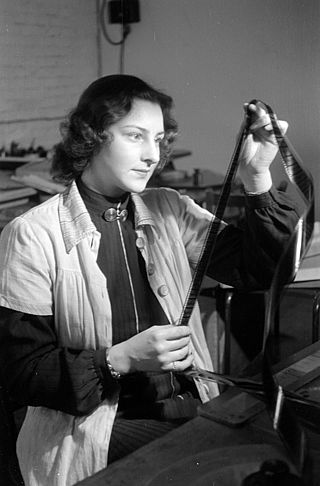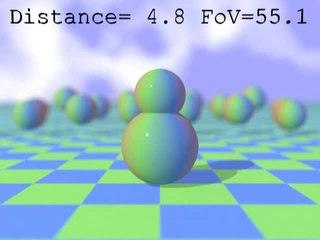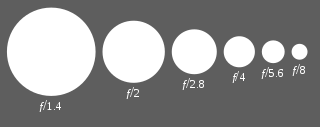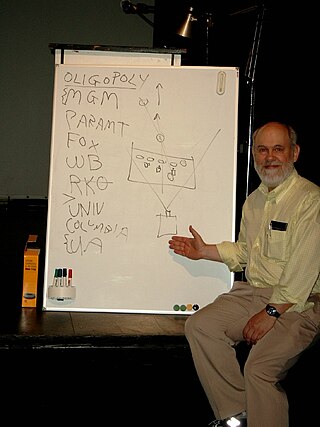Related Research Articles

Film editing is both a creative and a technical part of the post-production process of filmmaking. The term is derived from the traditional process of working with film which increasingly involves the use of digital technology. When putting together some sort of video composition, typically, you would need a collection of shots and footages that vary from one another. The act of adjusting the shots you have already taken, and turning them into something new is known as film editing.

A dolly zoom is an in-camera effect that appears to undermine normal visual perception.

A jump cut is a cut in film editing that breaks a single continuous sequential shot of a subject into two parts, with a piece of footage removed to create the effect of jumping forward in time. Camera positioning on the subject across the sequence should vary only slightly to achieve the effect. The technique manipulates temporal space using the duration of a single shot—fracturing the duration to move the audience ahead. This kind of cut abruptly communicates the passing of time, as opposed to the more seamless dissolve heavily used in films predating Jean-Luc Godard's Breathless, which extensively used jump cuts and popularized the technique in the 1960s. For this reason, jump cuts are considered a violation of classical continuity editing, which aims to give the appearance of continuous time and space in the story-world by de-emphasizing editing, but are sometimes nonetheless used for creative purposes. Jump cuts tend to draw attention to the constructed nature of the film. More than one jump cut is sometimes used in a single sequence.

The New Wave, also called the French New Wave, is a French art film movement that emerged in the late 1950s. The movement was characterized by its rejection of traditional filmmaking conventions in favor of experimentation and a spirit of iconoclasm. New Wave filmmakers explored new approaches to editing, visual style, and narrative, as well as engagement with the social and political upheavals of the era, often making use of irony or exploring existential themes. The New Wave is often considered one of the most influential movements in the history of cinema.
In filmmaking and video production, a shot is a series of frames that runs for an uninterrupted period of time. Film shots are an essential aspect of a movie where angles, transitions and cuts are used to further express emotion, ideas and movement. The term "shot" can refer to two different parts of the filmmaking process:
- In production, a shot is the moment that the camera starts rolling until the moment it stops.
- In film editing, a shot is the continuous footage or sequence between two edits or cuts.
In filmmaking, a long take is shot with a duration much longer than the conventional editing pace either of the film itself or of films in general. Significant camera movement and elaborate blocking are often elements in long takes, but not necessarily so. The term "long take" should not be confused with the term "long shot", which refers to the distance between the camera and its subject and not to the temporal length of the shot itself. The length of a long take was originally limited to how much film the magazine of a motion picture camera could hold, but the advent of digital video has considerably lengthened the maximum potential length of a take.

In filmmaking, the 180-degree rule is a basic guideline regarding the on-screen spatial relationship between a character and another character or object within a scene. The rule states that the camera should be kept on one side of an imaginary axis between two characters, so that the first character is always frame right of the second character. Moving the camera over the axis is called jumping the line or crossing the line; breaking the 180-degree rule by shooting on all sides is known as shooting in the round.
Continuity editing is the process, in film and video creation, of combining more-or-less related shots, or different components cut from a single shot, into a sequence to direct the viewer's attention to a pre-existing consistency of story across both time and physical location. Often used in feature films, continuity editing, or "cutting to continuity", can be contrasted with approaches such as montage, with which the editor aims to generate, in the mind of the viewer, new associations among the various shots that can then be of entirely different subjects, or at least of subjects less closely related than would be required for the continuity approach. When discussed in reference to classical Hollywood cinema, it may also be referred to as classical continuity.

Deep focus is a photographic and cinematographic technique using a large depth of field. Depth of field is the front-to-back range of focus in an image, or how much of it appears sharp and clear. In deep focus, the foreground, middle ground, and background are all in focus.

Classical Hollywood cinema is a term used in film criticism to describe both a narrative and visual style of filmmaking that first developed in the 1910s to 1920s during the latter years of the silent film era. It then became characteristic of American cinema during the Golden Age of Hollywood, between roughly 1927 and 1960. It eventually became the most powerful and pervasive style of filmmaking worldwide.
This article contains a list of cinematic techniques that are divided into categories and briefly described.

The 30-degree rule is a basic film editing guideline that states the camera should move at least 30 degrees relative to the subject between successive shots of the same subject. If the camera moves less than 30 degrees, the transition between shots can look like a jump cut—which could jar the audience and take them out of the story. The audience might focus on the film technique rather than the narrative itself.

David Jay Bordwell is an American film theorist and film historian. Since receiving his PhD from the University of Iowa in 1974, he has written more than fifteen volumes on the subject of cinema including Narration in the Fiction Film (1985), Ozu and the Poetics of Cinema (1988), Making Meaning (1989), and On the History of Film Style (1997).

Cutting on action or matching on action refers to film editing and video editing techniques where the editor cuts from one shot to another view that matches the first shot's action.
In film, a match cut is a cut from one shot to another in which the composition of the two shots are matched by the action or subject and subject matter. For example, in a duel a shot can go from a long shot on both contestants via a cut to a medium closeup shot of one of the duellists. The cut matches the two shots and is consistent with the logic of the action. This is a standard practice in film-making, to produce a seamless reality-effect.

An eyeline match is a film editing technique associated with the continuity editing system. It is based on the premise that an audience will want to see what the character on-screen is seeing. An eyeline match begins with a character looking at something off-screen, followed by a cut of another object or person: for example, a shot showing a man looking off-screen is followed by a shot of a television. Given the audience's initial interest in the man's gaze, it is generally implied on the basis of the second shot that the man in the first was looking at the television, even though the man is never seen looking at the television within the same shot.
Articles related to the field of motion pictures include:
In film studies, historical poetics is a scholarly approach to studying film, which David Bordwell outlined in his book Making Meaning (1989). Poetics studies the text itself rather than its production, reception or cultural significance and it can therefore be seen as a logical first step - though expressly not the last step - in terms of understanding how a narrative text works.
This glossary of motion picture terms is a list of definitions of terms and concepts related to motion pictures, filmmaking, cinematography, and the film industry in general.

The legacy of filmmaking technique left by Akira Kurosawa (1910–1998) for subsequent generations of filmmakers has been diverse and of international influence beyond his native Japan. The legacy of influence has ranged from working methods, influence on style, and selection and adaptation of themes in cinema. Kurosawa's working method was oriented toward extensive involvement with numerous aspects of film production. He was also an effective screenwriter who would work in close contact with his writers very early in the production cycle to ensure high quality in the scripts which would be used for his films.
References
- ↑ "Common editing terms explained". inspiredfilmandvideo.co.uk. Archived from the original on 21 April 2010. Retrieved 7 April 2010.
- 1 2 "Continuity Editing in Hitchcock's Rear Window". slideshare.net. Archived from the original on 11 June 2010. Retrieved 7 April 2010.
- 1 2 3 4 5 "Observations on cinema". David Bordwell. Archived from the original on 18 June 2010. Retrieved 7 April 2010.
- 1 2 "Observations on cinema". David Bordwell. Archived from the original on 18 June 2010. Retrieved 2 January 2011.
- ↑ "Observations on cinema". David Bordwell. Archived from the original on 21 February 2013. Retrieved 2 January 2011.